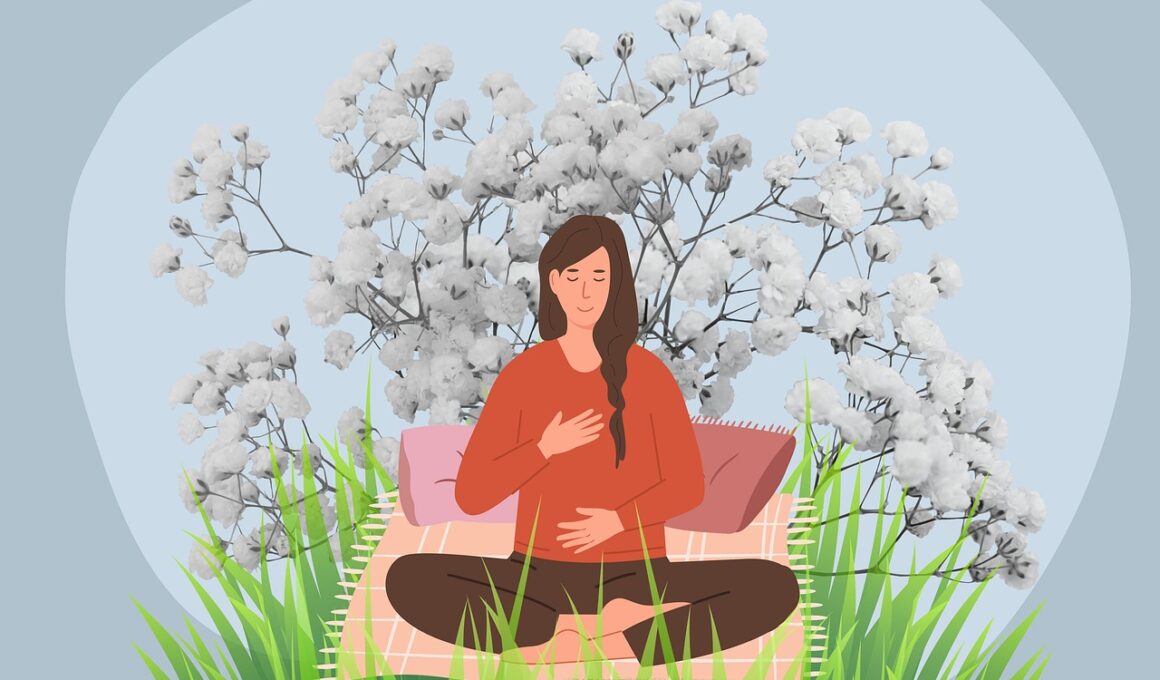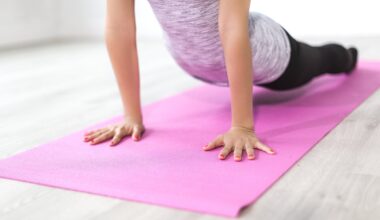How Breath Control Helps in Balance Disorders
Breathing techniques play a vital role in managing balance disorders. They can significantly improve posture and core stability, which are essential for maintaining balance. Controlled breathing helps activate the body’s proprioceptive system, enhancing one’s awareness of body position. When individuals practice specific breathing exercises, they often experience a reduction in symptoms related to dizziness and instability. Techniques such as diaphragmatic breathing provide increased oxygen flow, which supports better muscle function. Additionally, these exercises can reduce anxiety, a common factor that exacerbates balance issues. Integrating breathing techniques into daily routines can potentially lead to improved coordination and a greater sense of stability. Individuals with balance disorders may benefit from these exercises becoming a regular part of their physiotherapy. It is essential to note that consistency is key; practicing these techniques daily can yield significant results. Furthermore, mindfulness practices, including breath control and meditation, can improve overall well-being, motivating individuals to stay active. Clearly, understanding the link between breath control and balance is crucial for those affected by balance disorders, enabling them to adopt effective strategies for management.
Understanding how breathing impacts balance begins with recognizing the body-mind connection. When stressed, our breathing tends to become shallow, which can hinder physical performance. By incorporating deep breathing techniques, that stress can be alleviated, encouraging a more relaxed state of mind. This, in turn, allows the body to recalibrate and improve its balance capabilities. Mindful breathing encourages better concentration, which is particularly beneficial when executing physical activities that require coordination. The right breathing techniques can engage the core muscles that contribute to postural control, reducing the risk of falls. Techniques like the 4-7-8 breathing method promote relaxation, encouraging a slow and steady rhythm that supports balance enhancement. Breathing through the diaphragm can be practiced easily anywhere. Simple exercises can be incorporated into everyday life, making them accessible regardless of situations. Individuals who suffer from balance disorders may find temporary relief through these breathing strategies. Committing to daily breathing practices fosters mindfulness, which can further benefit the overall management of balance-related symptoms, ultimately providing a more harmonious relationship between mind and body.
Breathing Techniques That Improve Balance
Several effective breathing techniques focus on improving balance and coordination. One popular method is the Box Breathing technique. This involves inhaling for four counts, holding for four counts, exhaling for four counts, and then pausing again for four counts. This structured breathing helps refine focus. Another technique is the pursed-lip breathing, which is beneficial during exercise or rehabilitation sessions. By inhaling deeply through the nose and exhaling slowly through pursed lips, individuals can increase their endurance and maintain better stabilization. The Alternate Nostril Breathing technique is another remarkable method, believed to calm the mind and enhance concentration on balance tasks. Performing such techniques can also reduce muscle tension, allowing a more profound sense of control over body movements. It is essential to practice these methods consistently for maximum benefit. Incorporating breath control exercises into physical therapy sessions can provide an effective treatment framework for individuals dealing with balance disorders. Combining proper breathing with physical movements enhances overall coordination capabilities, transforming how an individual engages with their environment.
Additionally, engaging in yoga and tai chi incorporates breathing techniques that significantly contribute to enhanced balance and coordination. These practices not only focus on controlled breathing but also on body awareness and movement fluency. When performing yoga poses or tai chi sequences, deep breathing can improve muscle alignment and ease tension in the body. Individuals practicing these activities often report increased balance and reduced feelings of dizziness or instability. The flowing movements combined with focused breath create a holistic experience that nurtures balance. As strength and flexibility increase through regular practice, individuals often find improved spatial awareness and coordination. By staying attuned to breathing patterns, one can achieve a deeper connection with the body, fostering more confidence in balance-related activities. Such practices also enhance the sensory systems that contribute to maintaining equilibrium. Setting aside dedicated time for yoga or tai chi can lead to a refreshing and beneficial way to manage balance disorders. Ultimately, the incorporation of breathing into physical practices shows promising potential for those facing challenges with balance and coordination.
Mindfulness and Balance Improvement
Mindfulness, a practice often cultivated through techniques like meditation and focused breathing, can also significantly impact balance issues. It allows individuals to recognize their bodily sensations and positions, leading to improved spatial awareness. This heightened awareness can enhance balance by encouraging a more responsive connection to our environment. Practicing mindfulness through breathing exercises can further promote relaxation, lowering stress levels that might interfere with balance. By developing an understanding of breath and the body’s center of gravity through mindfulness, individuals can gain better control over their movements. Regular mindfulness practice encourages a focus on the present, enabling those with balance disorders to engage fully in physical activities without distractions. This immensely contributes to one’s confidence, knowing they can manage symptoms effectively. Simple mindfulness techniques can be integrated into daily life, providing much-appreciated moments of calm and clarity. It can empower individuals to take an active approach in managing their balance disorders. In incorporating such practices, they may ultimately improve their overall quality of life and enjoy a more stable, active existence.
In conclusion, the relationship between breathing techniques and balance improvements is evident among individuals experiencing balance disorders. Regular practice of controlled breathing can enhance muscle function, promote relaxation, and improve core strength, all crucial components of maintaining balance. The role of deep, mindful breathing cannot be overstated, as it clears the mind and prepares the body for physical activities. By embracing various techniques including yoga and meditation, individuals can significantly impact their overall well-being. In the context of balance disorders, consistency and commitment to practice are essential for achieving desired results. Integrating these methods into daily routines creates a harmonious balance of breath and movement, contributing to improved coordination while also fostering a sense of peace. Notably, it’s important to personalize these techniques to fit individual needs and preferences. Everyone’s experience will vary, and what works best may differ from person to person. Expanding options for breath control and its implementation will ultimately invite positive outcomes for those challenged by balance disorders. Empowering oneself through these techniques can lead to enhanced stability and quality of life.
Final Thoughts
Incorporating breath control techniques into the management of balance disorders encourages a multifaceted approach to therapy. For those seeking alternative strategies for better balance, understanding the importance of breathing may open new avenues for progress. Improvements in posture, focus, and body awareness are achieved through consistent practice of these techniques, highlighting their efficacy. Individuals experiencing balance disorders can use the knowledge gained to create personalized routines that support their unique needs. The path to navigating balance challenges does not have to be isolating; sharing experiences and techniques within support groups can foster greater awareness. Learning from others and advocating for oneself allows for a stronger foundation in combating balance issues. Professional guidance from physiotherapists can also enhance the effectiveness of these breathing techniques, leading to improved results in individual practices. Ultimately, the integration of breath control methods in conjunction with physical exercises promotes a holistic approach for addressing balance disorders. By committing to exploring these varied practices, individuals can experience significant improvements in confidence, stability, and overall physical health.
By leveraging breath control techniques and staying mindful, those with balance disorders can enhance their overall experience in managing symptoms. Physical activities often require a level of coordination, where improved breathing can help navigate challenges effectively. Sharing knowledge and experiences related to breath control can create a sense of community among individuals facing similar obstacles. By learning together, practitioners can motivate one another, fostering prolonged commitment to practicing these techniques. The focus on breathing and awareness strengthens both the body and mind, promoting an overall sense of well-being. As individuals navigate their path toward improved balance, they may also uncover new ways to interact with their environment. Understanding the powerful effects of controlled breathing can lead to greater acceptance of oneself. By incorporating a variety of techniques, everyone can find methods that resonate with them, aiding in the development of their personalized practices. This iterative process not only allows for deeper exploration but also cultivates resilience in overcoming balance challenges. As a comprehensive strategy emerges, it empowers individuals to thrive and fully embrace their physical capabilities.


